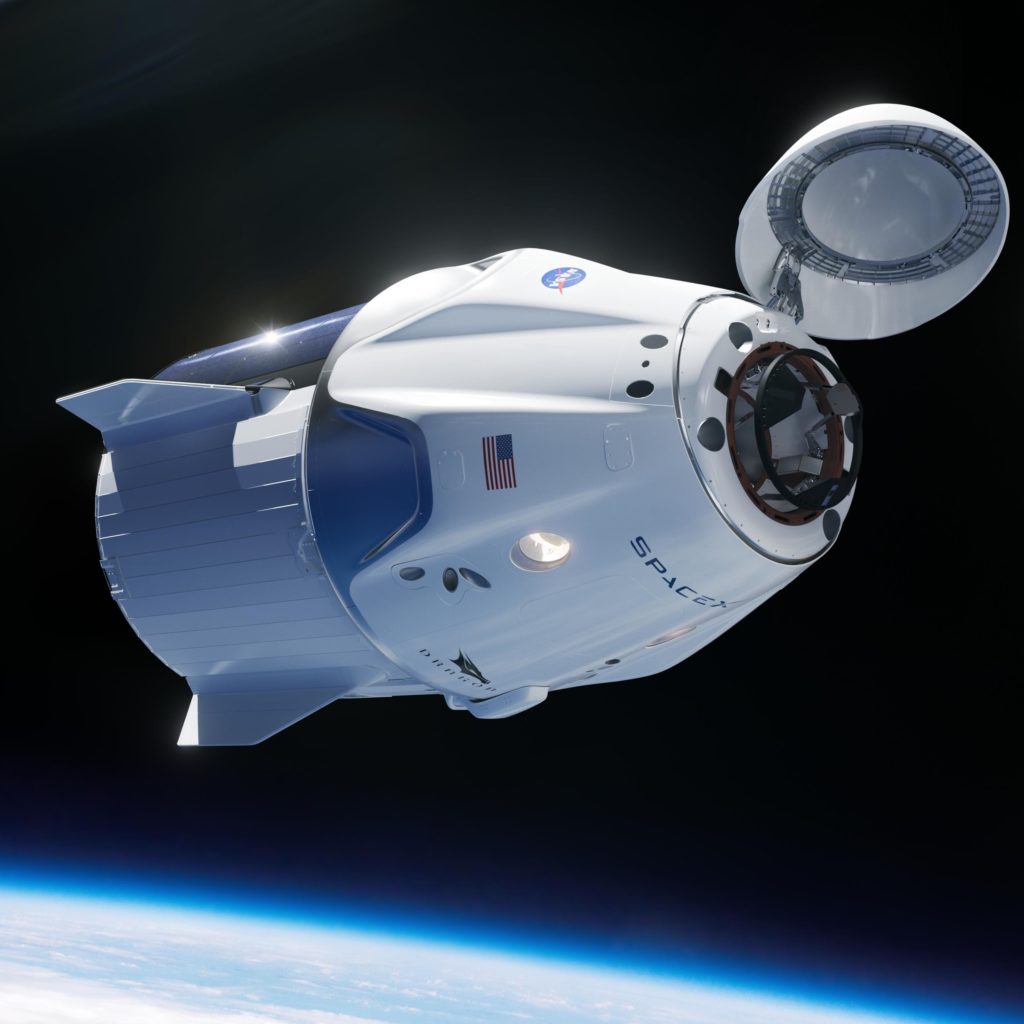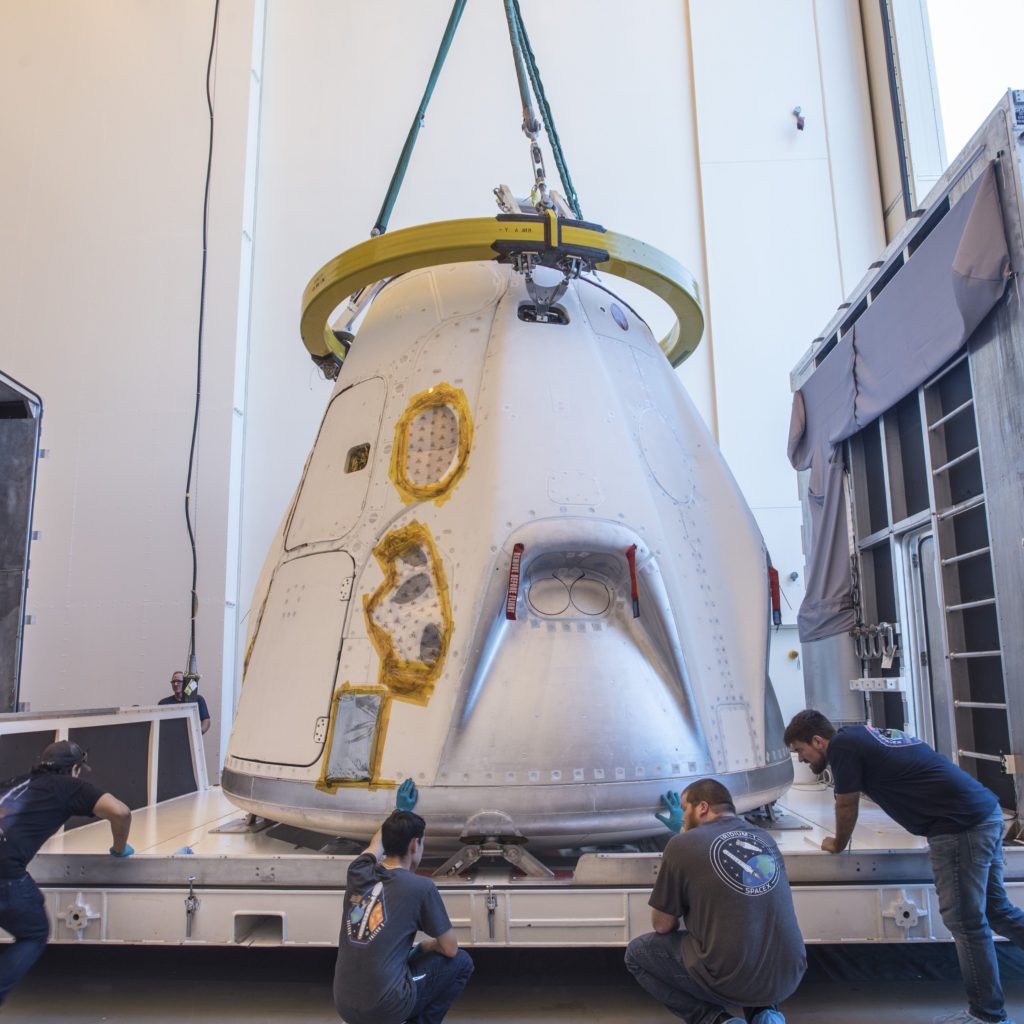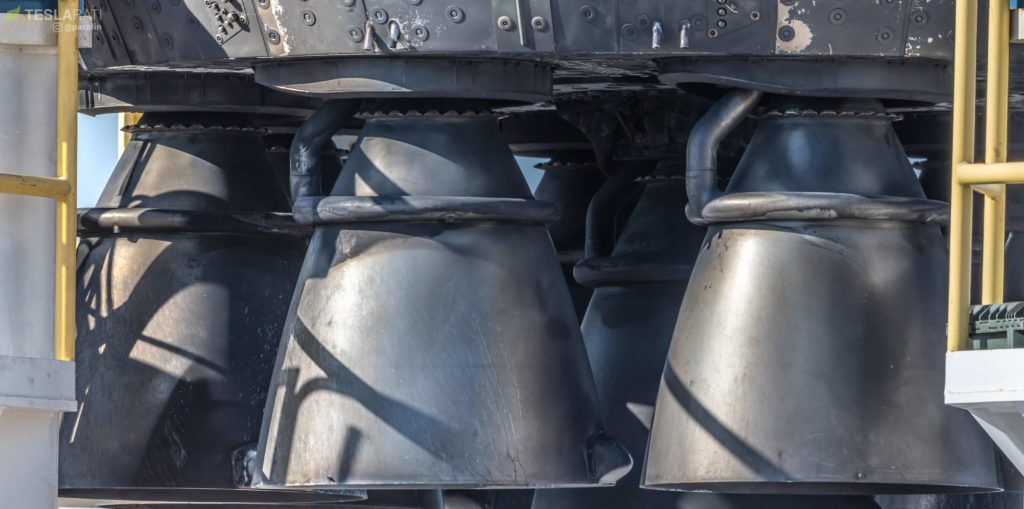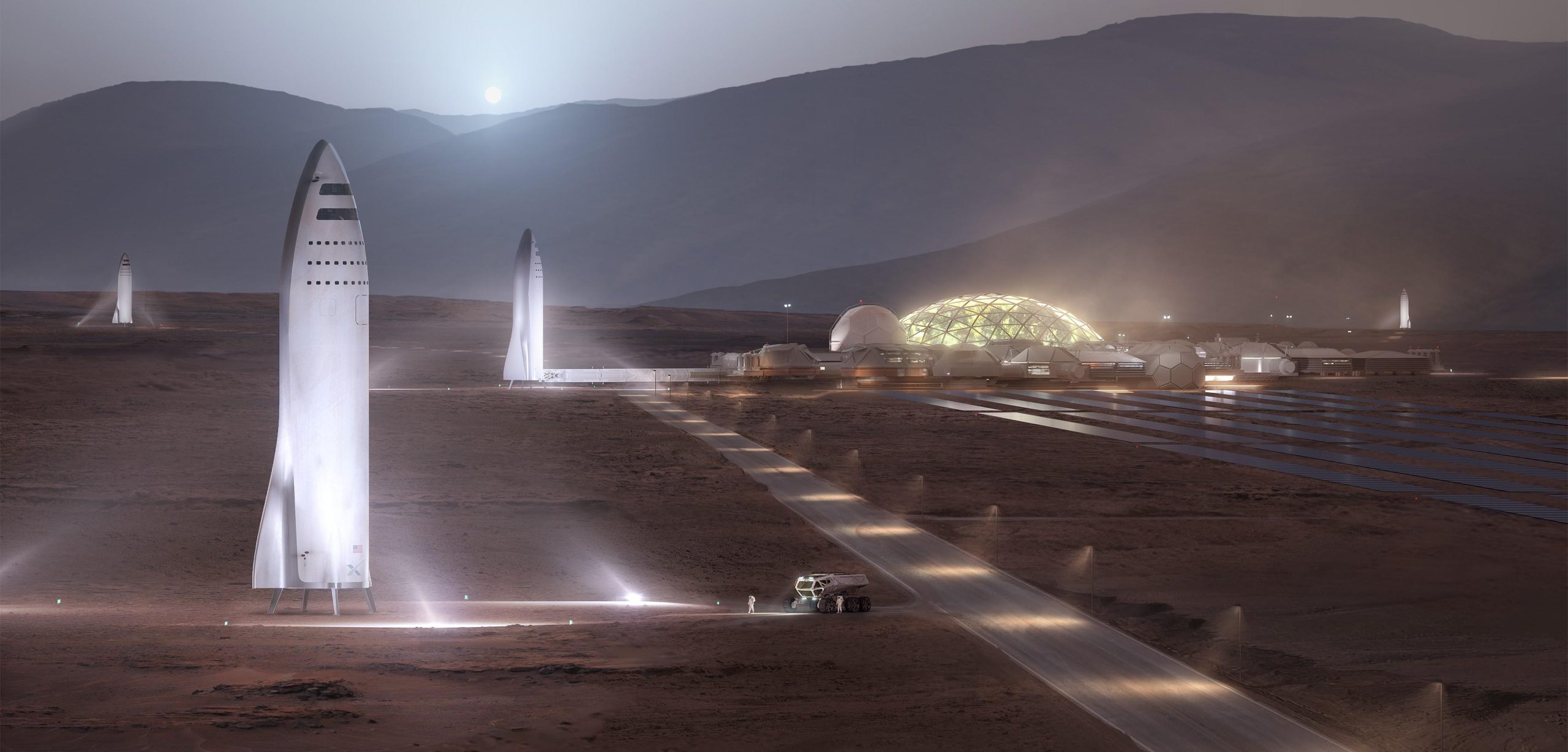
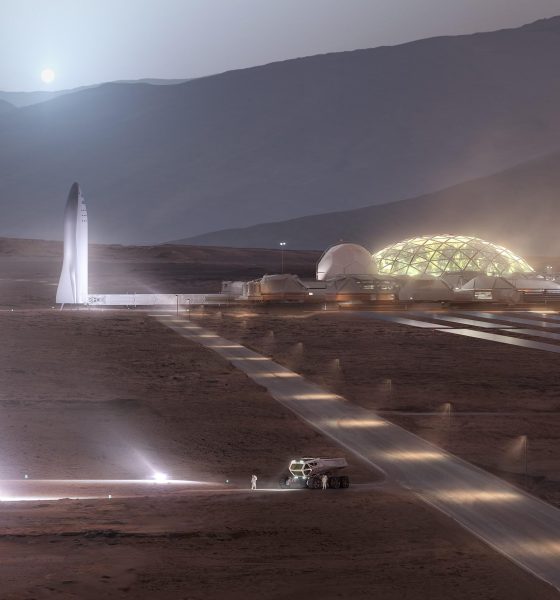
News
SpaceX is searching for BFR landing sites for early 2020s Mars missions
SpaceX Principal Mars Development Engineer Paul Wooster gave a surprise talk at a February 2018 meeting of the Mars Exploration Program Analysis Group, where he provided a brief overview of SpaceX’s plans for the Red Planet, ranging from prospective landing sites for the company’s first missions there to the possibility of including significant secondary payloads on BFR and Falcon Heavy launches.
Wooster reiterated that SpaceX is still targeting the early 2020s for its first true BFR missions to Mars, perhaps less than five years from today. He further discussed prospective landing locations on the planet, emphasizing a need for a smooth landing site, easy access to on or near-surface water ice, and a preference for the warmer and more forgiving mid and low (equatorial) latitudes. A huge amount of work admittedly remains before the company before those missions are even remotely conceivable, especially missions with crew onboard.
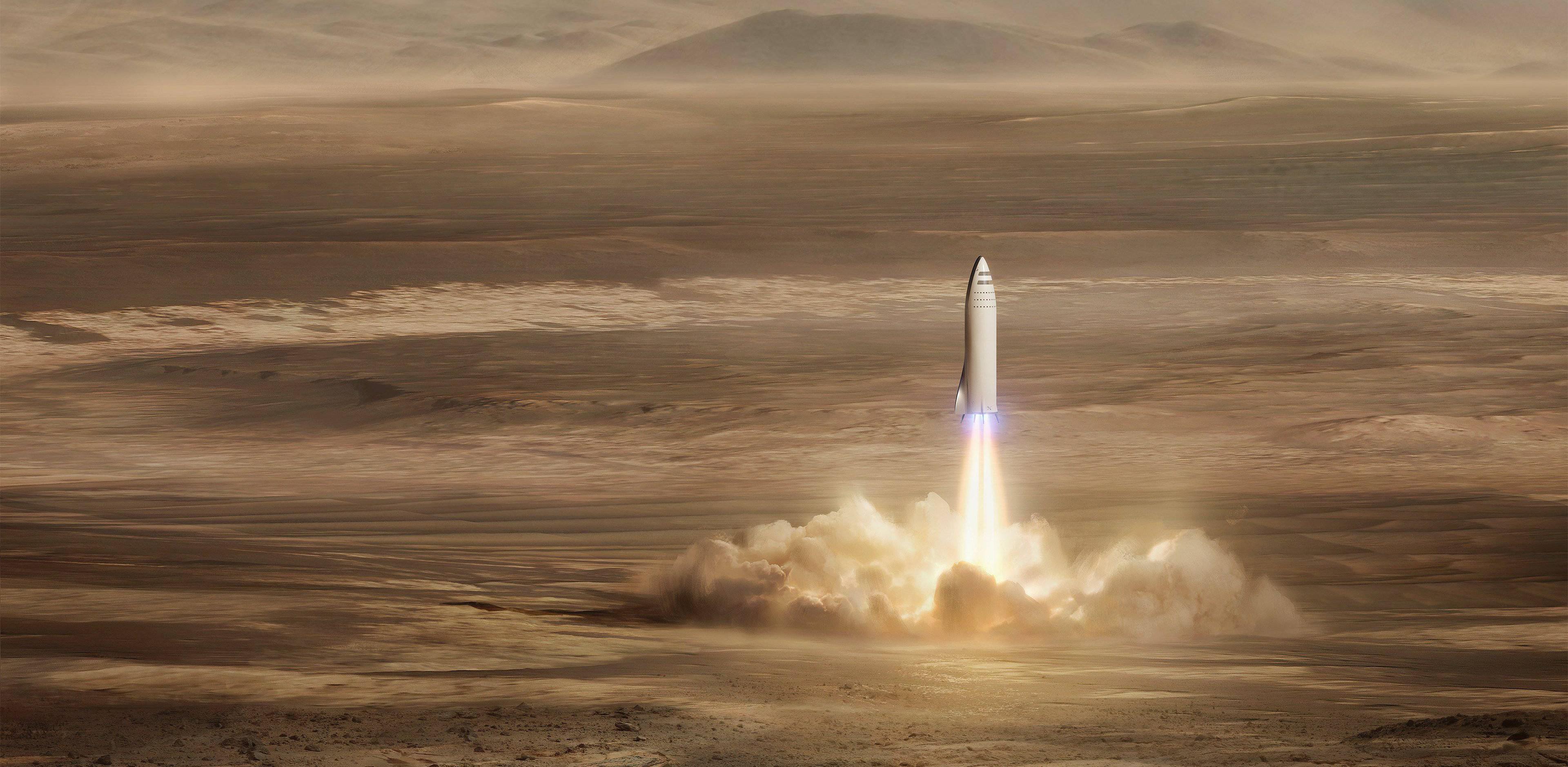
If/when SpaceX successfully debuts its Crew Dragon spacecraft and demonstrates the ability to reliably and safely transport humans to and from orbit, a huge amount of the risk currently innate in any long-term interplanetary transport and colony creation will be definitively retired, transforming several of the major problems at hand from clean-slate tech development to optimizing and scaling up functional first-generation designs and hardware.
Crew Dragon’s official uncrewed demonstration debut (DM-1) and perhaps the crewed demonstration follow-on mission (DM-2) will likely have real launch dates announced later this week in an August 3 NASA press conference. Reliable sources have pegged those dates around October-December for DM-1 and 3-6 months later for DM-2
- SpaceX’s gorgeous Crew Dragon capsule is nearing its own debut, likely before the end of 2018. (SpaceX)
- The first spaceworthy Crew Dragon capsule is already in Florida, preparing for its November 2018 launch debut. The same capsule will be refurbished and reflown as few as three months after recovery. (SpaceX)
- Note that Merlin 1D and prior Raptor prototypes both feature traditional single nozzles. (Pauline Acalin)
Nevertheless, SpaceX is demonstrably hard at work designing and building BFR‘s booster, spaceship, and tanker and is moving quickly in the direction of full-scale engineering and production. Much of that prototype manufacturing happens to be taking place in a temporary tent installed in a Port of Los Angeles parking lot near the end of 2017. According to one source engaged in the work there, SpaceX technicians and engineers have already begun rolling out preliminary materials and engineering samples of carbon composite structures and propellant tanks with the massive manufacturing tools (one known as a mandrel) temporarily housed inside.
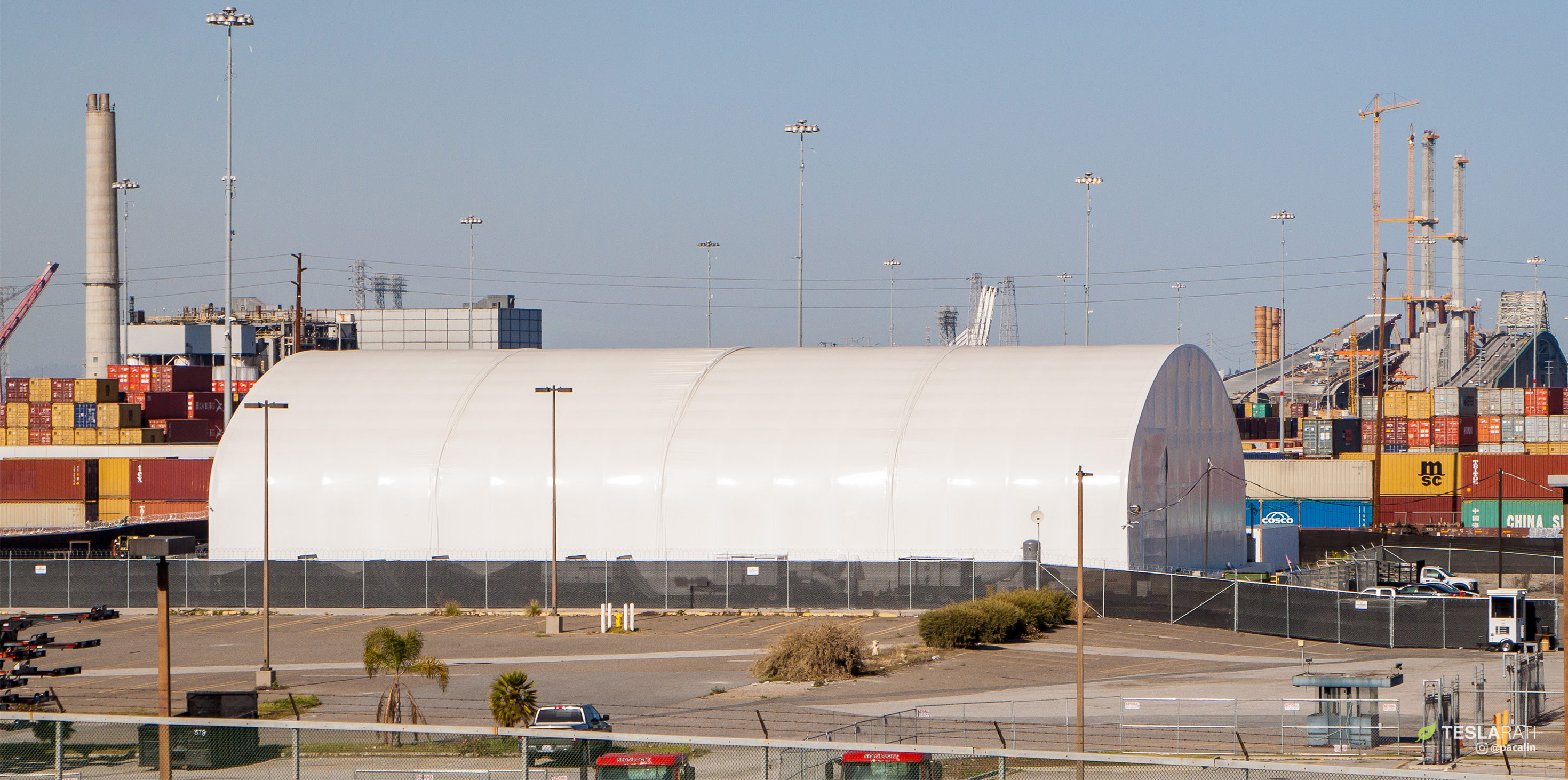
Just a few miles away, the company is busy preparing a construction site for a permanent BFR factory on a plot of Port of Los Angeles land known as Berth 240. The smaller Phase 1 of that BFR factory is expected to be completed roughly a year after construction begins, placing the inauguration of the dedicated facility sometime around the middle of 2019. Suborbital launches of the massive rocket’s upper stage spaceship are expected in 2019, while orbital launches of BFR are NET 2020.
Read the full summary of Mr. Wooster’s presentation below.
“A walk-on presentation was given by Paul Wooster of SpaceX which highlighted the recent successful test of the Falcon Heavy launch vehicle with its potentially very large payload capacity (100 metric tons). Using the Falcon Heavy and development of an even larger Big Falcon Rocket (BFR) launcher are the basis of their ambitious plans for the future exploration and colonization of Mars, potentially launching missions to Mars within the early 2020s. SpaceX’s current landing site candidates for Mars were shown, having been chosen to provide access to near-surface ice, few landing site hazards (such as large rocks), and enough space for potentially growing a sizeable outpost. The ice sites are in high mid-latitudes and the search for lower latitude candidates, which are preferred, continues. Previously, MEPAG had been told that SpaceX could transport for-fee payloads to the Mars surface. In response to questions, Paul iterated that there is likely to be capacity for secondary payloads on either the Falcon Heavy or BFR launchers, although details remain to be negotiated once the launcher capabilities are firmly established.”
For prompt updates, on-the-ground perspectives, and unique glimpses of SpaceX’s rocket recovery fleet (including fairing catcher Mr Steven) check out our brand new LaunchPad and LandingZone newsletters!

News
Tesla FSD approved for testing in Nacka, Sweden, though municipality note reveals aggravating detail
Nacka, Sweden, a municipality just a few miles from Stockholm, has given its approval for FSD tests.
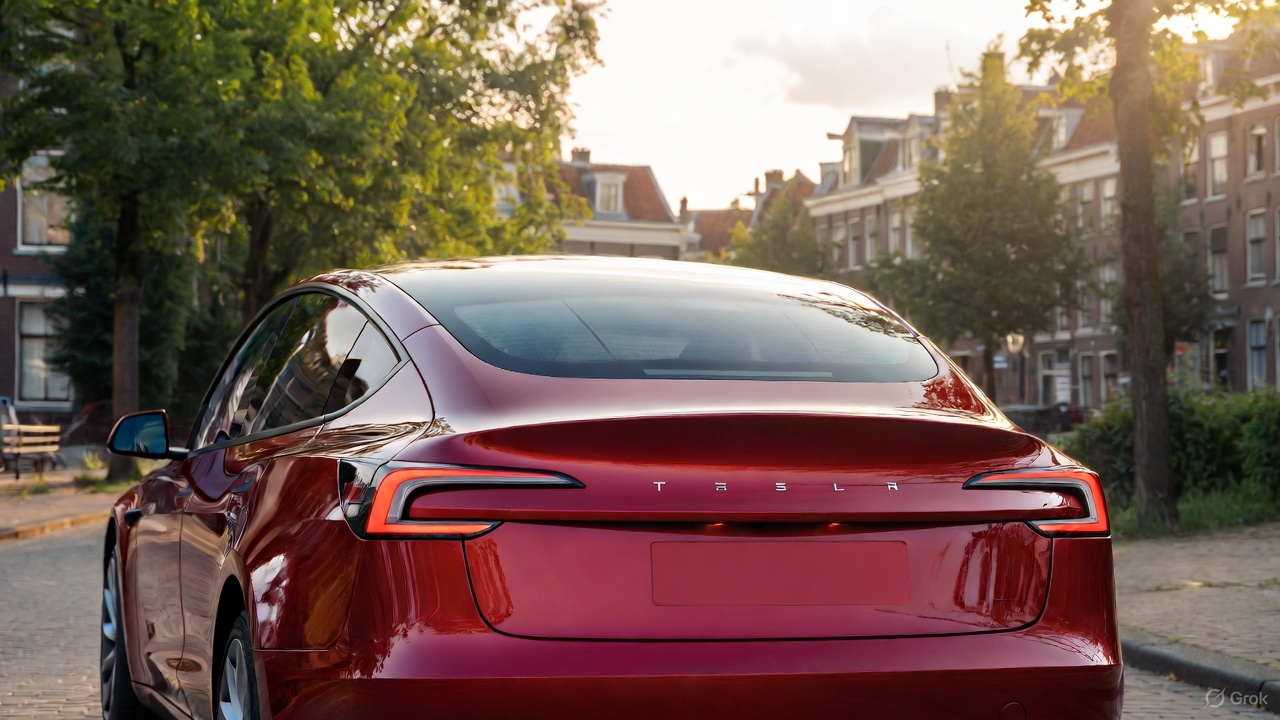
Tesla has secured approval for FSD testing in an urban environment in Sweden. As per recent reports from the Tesla community, Nacka, Sweden, a municipality just a few miles from Stockholm, has given its approval for FSD tests.
A look at the municipality’s note regarding FSD’s approval, however, reveals something quite aggravating.
FSD testing approval secured
As per Tesla watcher and longtime shareholder Alexander Kristensen, Nacka is governed by the Moderate Party. The shareholder also shared the municipality’s protocol notes regarding approval for FSD’s tests.
“It is good that Nacka can be a place for test-driving self-driving cars. This is future technology that can both facilitate mobility and make transportation cheaper and more environmentally friendly,” the note read.
The update was received positively by the Tesla community on social media, as it suggests that the electric vehicle maker is making some legitimate headway in releasing FSD into the region. Sweden has been particularly challenging as well, so securing approval in Nacka is a notable milestone for the company’s efforts.
Aggravating details
A look at the notes from Nacka shows that FSD’s proposed tests still met some opposition from some officials. But while some critics might typically point to safety issues as their reasons for rejecting FSD, those who opposed the system in Nacka openly cited Tesla’s conflict with trade union IF Metall in their arguments. Fortunately, Nacka officials ultimately decided in Tesla’s favor as the company’s issues with the country’s unions are a completely different matter.
“The left-wing opposition (S, Nackalistan, MP and V) voted no to this, referring to the fact that the applicant company Tesla is involved in a labor market conflict and does not want to sign a collective agreement. We believe that this is not an acceptable reason for the municipality to use its authority to interfere in a labor law conflict.
“Signing a collective agreement is not an obligation, and the company has not committed any crime. The municipality should contribute to technological development and progress, not work against the future,” the note read.
News
Tesla Model 3 and Model Y named top car buys in Norway
Despite growing competition from European and Korean brands, both models stood out for their balance of price, performance, and everyday usability.
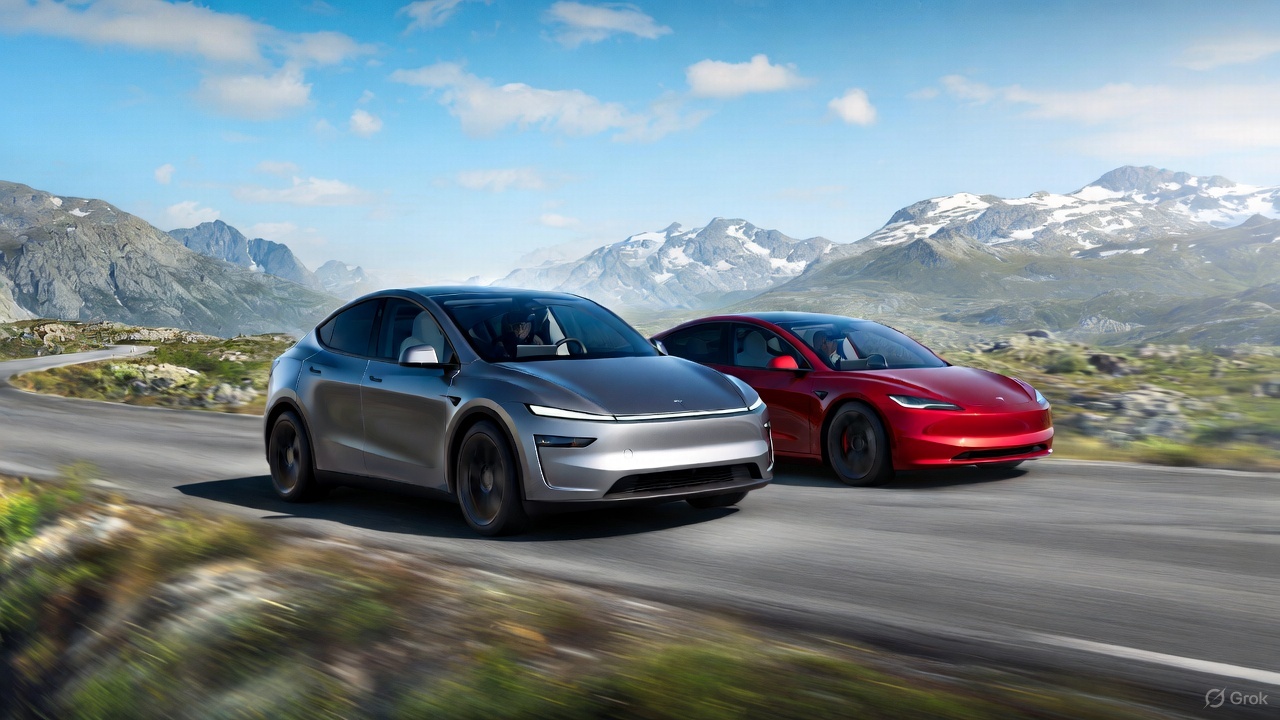
Norway’s annual roundup of the best car purchases featured Tesla’s two main sellers this year, with the Model 3 and Model Y securing top positions in their respective segments.
Despite growing competition from European and Korean brands, both models stood out for their balance of price, performance, and everyday usability. The verdict comes as electric vehicle adoption remained above 95% of new vehicle sales in the country.
Tesla Model 3 strengthens its value position
Among compact EVs, the Tesla Model 3 maintained its position as the best overall buy thanks to its strong blend of performance, efficiency, and updated features. Reviewers noted that every trim offered compelling value, especially with the all-electric sedan’s improved cabin ergonomics and the return of the turn-signal stalk, which was one of the few previous complaints among drivers.
The Model 3’s mix of long-range capability, low operating costs, and responsive handling has continued to set the benchmark for compact EVs in Norway. While competitors from Hyundai, Volkswagen, and Peugeot have narrowed the gap, Tesla’s price-to-capability ratio has remained difficult to beat in this segment, Motor.no reported.
“The Model 3 clearly offers the best value for money in the compact class, no matter which version you choose. Now it also gets the turn signal lever back. This eliminates one of the few flaws in a driving environment that many believe is the best on the market,” the publication wrote.
Tesla Model Y claims its crown
The Tesla Model Y emerged as Norway’s top family-car purchase this year. The latest refresh introduced improvements in ride quality, styling, and interior materials, allowing the Model Y to deliver a more premium driving experience without a substantial price increase.
Reviewers praised its spacious cabin, strong safety profile, and practical range, all of which reinforced its appeal for families needing an all-purpose electric crossover. The Model Y remains especially notable given its continued popularity in Norway even as Tesla faces declining sales in other global markets.
“The Model Y is back as the winner in the family class. The upgrade in the new year was even more extensive than expected. It is a slightly more elegant and significantly more comfortable Model Y that solidifies its position as Norway’s best car purchase in the most important class,” the Norwegian motoring publication noted.
News
Tesla Giga Berlin is still ramping production to meet Model Y demand: plant manager
Tesla Gigafactory Berlin has expanded to two full shifts, as per the facility’s plant manager, and a lot of it is due to Model Y demand.
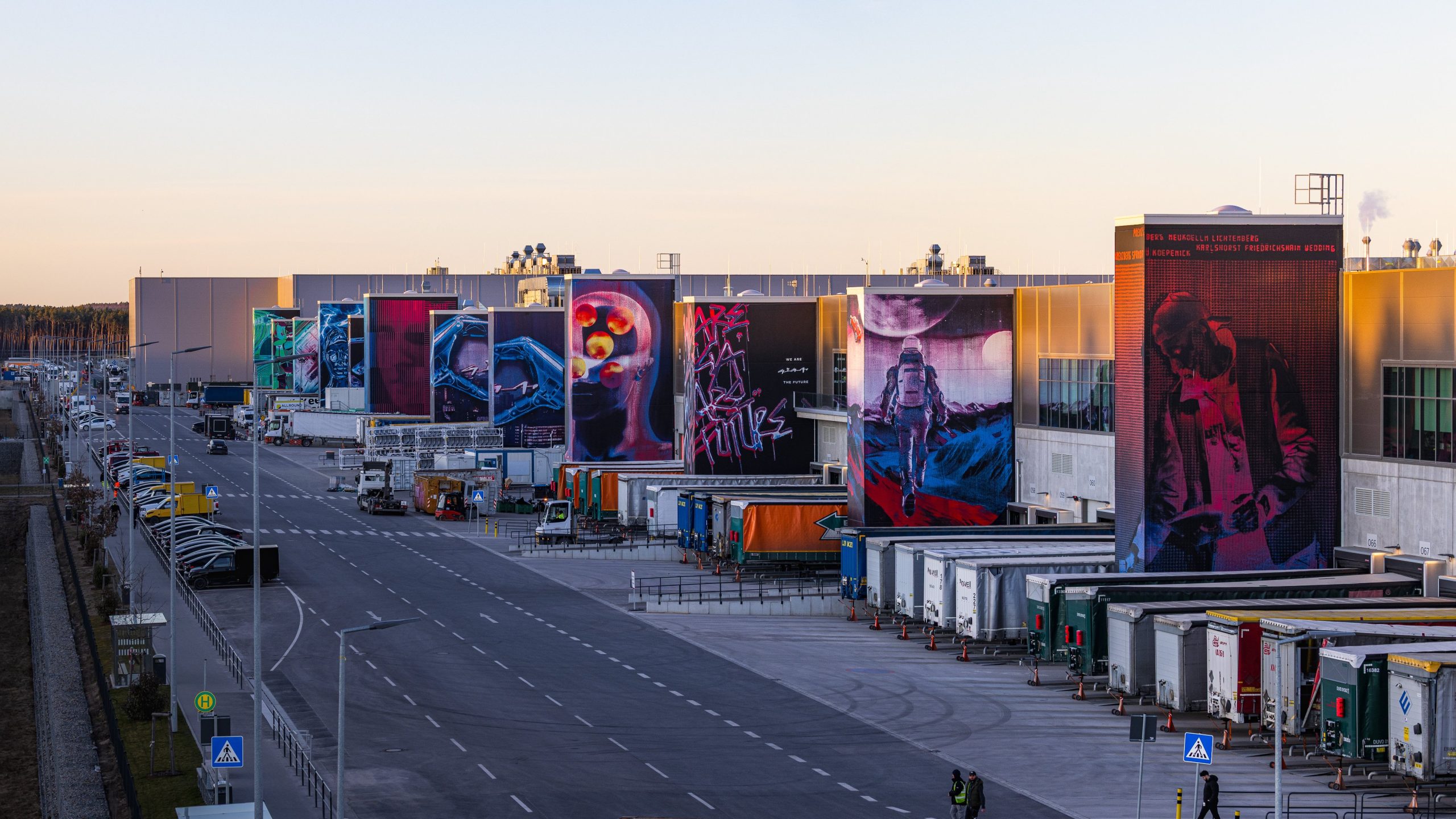
Tesla Gigafactory Berlin has expanded to two full shifts, as per the facility’s plant manager, and a lot of it is due to Model Y demand. While registrations in some countries such as Sweden have fallen sharply this year, the company’s sales in other key territories have been rising.
Giga Berlin shifts to two shifts
Giga Berlin factory manager André Thierig told the DPA that the facility has been running two shifts since September to manage a surge in global orders. And due to the tariff dispute with the United States, vehicles that are produced at Giga Berlin are now being exported to Canada.
“We deliver to well over 30 markets and definitely see a positive trend there,” Thierig said.
Despite Giga Berlin now having two shifts, the facility’s production still needs to ramp up more. This is partly due to the addition of the Tesla Model Y Performance and Standard, which are also being produced in the Grunheide-based factory. Interestingly enough, Giga Berlin still only produces the Model Y, unlike other factories like Gigafactory Texas, the Fremont Factory, and Gigafactory Shanghai, which produce more than one type of vehicle.
Norway’s momentum
Norway, facing an imminent tax increase on cars, has seen a historic spike in Tesla purchases as buyers rush to secure deliveries before the change takes effect, as noted in a CarUp report. As per recent reports, Tesla has broken Norway’s all-time annual sales record this month, beating Volkswagen’s record that has stood since 2016.
What is rather remarkable is the fact that Tesla was able to achieve so much in Norway with one hand practically tied behind its back. This is because the company’s biggest sales draw, FSD, remains unavailable in the country. Fortunately, Tesla is currently hard at work attempting to get FSD approved for Europe, a notable milestone that should spur even more vehicle sales in the region.
